DNA binding: a novel function of Pseudomonas aeruginosa type IV pili
- PMID: 15687210
- PMCID: PMC545619
- DOI: 10.1128/JB.187.4.1455-1464.2005
DNA binding: a novel function of Pseudomonas aeruginosa type IV pili
Abstract
The opportunistic pathogen Pseudomonas aeruginosa produces multifunctional, polar, filamentous appendages termed type IV pili. Type IV pili are involved in colonization during infection, twitching motility, biofilm formation, bacteriophage infection, and natural transformation. Electrostatic surface analysis of modeled pilus fibers generated from P. aeruginosa strain PAK, K122-4, and KB-7 pilin monomers suggested that a solvent-exposed band of positive charge may be a common feature of all type IV pili. Several functions of type IV pili, including natural transformation and biofilm formation, involve DNA. We investigated the ability of P. aeruginosa type IV pili to bind DNA. Purified PAK, K122-4, and KB-7 pili were observed to bind both bacterial plasmid and salmon sperm DNA in a concentration-dependent and saturable manner. PAK pili had the highest affinity for DNA, followed by K122-4 and KB-7 pili. DNA binding involved backbone interactions and preferential binding to pyrimidine residues even though there was no evidence of sequence-specific binding. Pilus-mediated DNA binding was a function of the intact pilus and thus required elements present in the quaternary structure. However, binding also involved the pilus tip as tip-specific, but not base-specific, antibodies inhibited DNA binding. The conservation of a Thr residue in all type IV pilin monomers examined to date, along with the electrostatic data, implies that DNA binding is a conserved function of type IV pili. Pilus-mediated DNA binding could be important for biofilm formation both in vivo during an infection and ex vivo on abiotic surfaces.
Figures
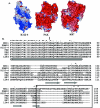

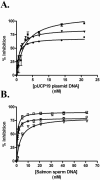
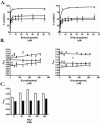
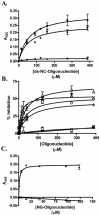
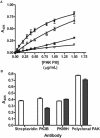
Similar articles
-
The Pseudomonas aeruginosa type IV pilin receptor binding domain functions as an adhesin for both biotic and abiotic surfaces.Mol Microbiol. 2006 Feb;59(4):1083-96. doi: 10.1111/j.1365-2958.2005.05002.x. Mol Microbiol. 2006. PMID: 16430686
-
Crystallographic analysis of the Pseudomonas aeruginosa strain K122-4 monomeric pilin reveals a conserved receptor-binding architecture.Biochemistry. 2004 Sep 14;43(36):11427-35. doi: 10.1021/bi048957s. Biochemistry. 2004. PMID: 15350129
-
Pseudomonas aeruginosa Type IV pilus expression in Neisseria gonorrhoeae: effects of pilin subunit composition on function and organelle dynamics.J Bacteriol. 2007 Sep;189(18):6676-85. doi: 10.1128/JB.00407-07. Epub 2007 Jun 15. J Bacteriol. 2007. PMID: 17573479 Free PMC article.
-
How Bacteria Use Type IV Pili Machinery on Surfaces.Trends Microbiol. 2015 Dec;23(12):775-788. doi: 10.1016/j.tim.2015.09.002. Epub 2015 Oct 22. Trends Microbiol. 2015. PMID: 26497940 Review.
-
The type-4 pilus is the major virulence-associated adhesin of Pseudomonas aeruginosa--a review.Gene. 1997 Jun 11;192(1):99-108. doi: 10.1016/s0378-1119(97)00116-9. Gene. 1997. PMID: 9224879 Review.
Cited by
-
Biofilms formed by nontypeable Haemophilus influenzae in vivo contain both double-stranded DNA and type IV pilin protein.J Bacteriol. 2007 May;189(10):3868-75. doi: 10.1128/JB.01935-06. Epub 2007 Feb 23. J Bacteriol. 2007. PMID: 17322318 Free PMC article.
-
Identification of surprisingly diverse type IV pili, across a broad range of gram-positive bacteria.PLoS One. 2011;6(12):e28919. doi: 10.1371/journal.pone.0028919. Epub 2011 Dec 21. PLoS One. 2011. PMID: 22216142 Free PMC article.
-
Membrane vesicles: an overlooked component of the matrices of biofilms.J Bacteriol. 2006 Aug;188(16):5945-57. doi: 10.1128/JB.00257-06. J Bacteriol. 2006. PMID: 16885463 Free PMC article.
-
eDNA Inactivation and Biofilm Inhibition by the PolymericBiocide Polyhexamethylene Guanidine Hydrochloride (PHMG-Cl).Int J Mol Sci. 2022 Jan 10;23(2):731. doi: 10.3390/ijms23020731. Int J Mol Sci. 2022. PMID: 35054915 Free PMC article.
-
Structure and function of PilQ, a secretin of the DNA transporter from the thermophilic bacterium Thermus thermophilus HB27.J Biol Chem. 2011 Mar 25;286(12):9977-84. doi: 10.1074/jbc.M110.212688. Epub 2011 Feb 1. J Biol Chem. 2011. PMID: 21285351 Free PMC article.
References
-
- Aas, F. E., M. Wolfgang, S. Frye, S. Dunham, C. Løvold, and M. Koomey. 2002. Competence for natural transformation in Neisseria gonorrhoeae: components of DNA binding and uptake linked to type IV pilus expression. Mol. Microbiol. 46:749-760. - PubMed
-
- Audette, G. F., R. T. Irvin, and B. Hazes. 2004. Crystallographic analysis of the Pseudomonas aeruginosa strain K122-4 monomeric pilin reveals a conserved receptor binding architecture. Biochemistry 43:11427-11435. - PubMed
-
- Audette, G. F., E. J. van Schaik, B. Hazes, and R. T. Irvin. Posting date, 9 September 2004. DNA-binding protein nanotubes: learning from nature's nanotech examples. Nano Lett. 4:1897-1902.[Online.]
-
- Bradley, D. E. 1974. The adsorption of Pseudomonas aeruginosa pilus-dependent bacteriophage to a host mutant with non-retractile pili. Virology 58:149-163. - PubMed
-
- Bradley, D. E., and T. L. Pitt. 1974. Pilus dependence of four Pseudomonas aeruginosa bacteriophages with non-contractile tails. J. Virol. 24:1-15. - PubMed
Publication types
MeSH terms
Substances
LinkOut - more resources
Full Text Sources
Other Literature Sources

